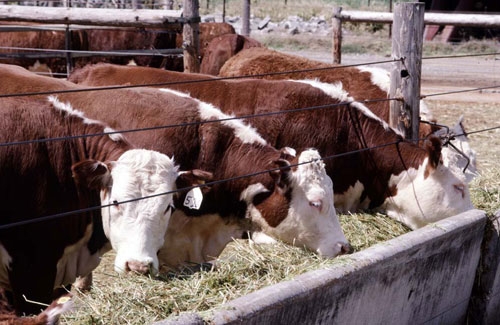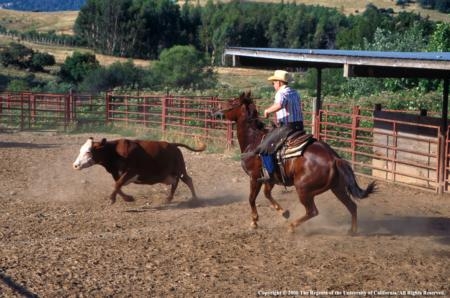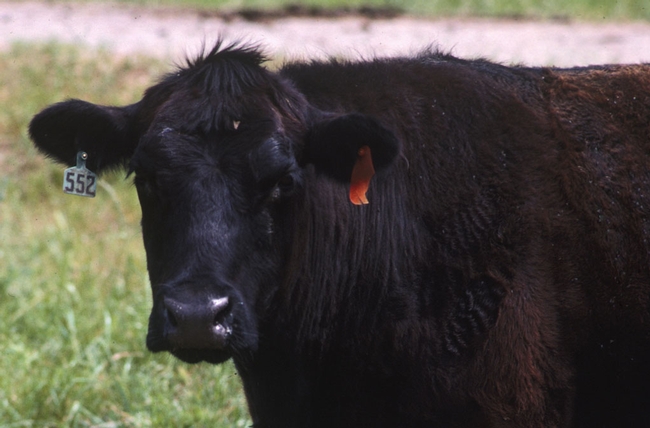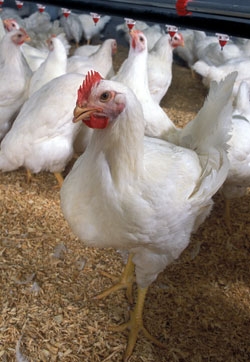Posts Tagged: beef
The hills are green, but the grass is going to seed
Ranchers rely on unirrigated rangeland to feed cattle through the winter. This year, a lack of rain required ranchers to bring in supplemental feed and cull their herds early.
Theresa Becchetti, UC Cooperative Extension advisor in Stanislaus County, said much of the grass growth on rangeland has slowed and is going to seed, though there are some grass species still growing that “can take advantage of the rain we have had," Holland reported.
Becchetti and other experts are collecting vegetation samples in the region, which could be used in requests for federal disaster aid.
A UC research station in Yuba County offers a glimpse of what could be found around much of the state, the story said. As of March 1, dry matter in grasses averaged 400 pounds per acre, compared with a historical average of 685 pounds and a high of 1,590 in rainy 1997.
The price of chicken feed is rising
Soaring feed costs are forcing San Joaquin Valley poultry producers to cut costs, raise prices - and, in some cases, close their doors, reported Robert Rodriguez in the Fresno Bee this weekend. Feed prices have climbed as much as 50 percent since last year, fueled by the increasing demand for corn.
Director of the UC Agricultural Issues Center Daniel Sumner told the reporter that rising costs for poultry producers will boost the retail price, unless something else acts to keep prices down.
"So, bottom line," Sumner said, "we should see higher retail prices with these high grain and oilseed prices."
Ranchers beef over obstacles to local meat
Carlos Alcalá, Sacramento Bee
Small ranchers in El Dorado County gathered at a Local Meat Summit in Placerville last week to discuss obstacles to selling their products locally. Meat must be harvested at a USDA-approved facility, and there aren't many of those.
Program representative Sean Kriletich of UC Cooperative Extension in Amador and Calaveras counties is working with ranchers to solve the problem.
"We're trying to work toward getting a USDA-inspected facility for our region," Kriletich said.
If more small ranchers can find a way to sell grass-fed beef locally, it will do more than benefit the farmers, Kriletich said. It will preserve open space for the entire community.
"If people want to keep more land in agriculture, we have to get more money to the producers," said Kriletich, who said he used to run cattle himself, where El Dorado Hills subdivisions now sit.
Beekeepers asking Humboldt cities to loosen regulations on residential hives
Grant Scott-Goforth, The Willits News
A recent change in attitudes toward urban sustainability and education about bee culture spurred the Humboldt County Beekeepers Association to ask the cities of Arcata and Eureka to loosen restrictions on residential beekeeping.
UC Cooperative Extension farm advisor Deborah Giraud said the risks of keeping bees in residential areas are minimal. ”In general, it's really important to have more honeybees,” Giraud said. “We have a lot of problems with pollination here because of weather. Most calls in here are about fruit trees. And it's a pollination problem.”
Curing pneumonia in cattle
Bovine respiratory disease - pneumonia in cattle - is the most significant health problem for the beef industry. The disease annually results in the death of more than 1 million animals. In addition to these losses, beef producers spend a significant sum on disease-related medication and labor costs each year.
According to AgInfo.net, raising cattle for specific resistance to BRD was a hot topic at the Beef Improvement Federation Conference earlier this month in Bozeman, Mont. Attendees learned about research under way at UC Davis to find the genetic component to BRD resistance and, eventually, breed out this deadly disease.
This spring, UC Davis announced that USDA awarded the university $2.6 million to carry out research aimed at reducing the incidence of bovine respiratory disease. The goal of the newly funded research project is to integrate research, education and extension activities to improve diagnostics and develop cost-effective genomic and management approaches that reduce the incidence of the BRD in beef and dairy cattle.
The extension component of the project is headed by Alison Van Eenennaam, Cooperative Extension specialist in animal genomics and biotechnology in the UC Davis Department of Animal Science. Van Eenennaam made a presentation at the Bozeman conference about the weight cattle producers should be give to BRD resistance when making selection decisions.

Twenty-nine percent of beef cattle deaths are associated with bovine respiratory disease.
It's boon time for beef producers
Cattle ranchers are enjoying an economic boon, reported Reed Fujii of the Stockton Record. In March, beef cattle were being sold at an all-time high of $1.16 a pound, a jump of more than 40 percent in less than two years.
"Prices are good. They've never been this good before," the story quoted Galt rancher Duane Martin Jr.
Dan Sumner, director of the UC Agricultural Issues Center, told Fujii the primary driver of the price hike is short beef supply.
"One of the things that happened a few years ago: We had these incredibly high grain prices, and beef prices didn't go up, so that meant guys were selling," Sumner was quoted.
In addition, it takes time to beef up production.
"Cattle make cattle; the only way you make marketable animals is to have breeding stock," Sumner said.
To do so, however, will further reduce beef supplies in the short run.
A steak house owner told Fujii that so far he has not increased the prices of beef on the menu.
"I've absorbed everything for the last year or so on beef," he said.

High beef prices make for happy cowboys.
Lack of local slaughterhouse enlarges footprint
The efforts of grass-fed beef producers in Northern California to shrink their carbon footprints are frustrated by the need to truck animals long distances to the nearest slaughterhouse, according to an article in today's Santa Rosa Press Democrat.
“There just aren't enough of these smaller plants people can go to,” the article quoted John Harper, UC Cooperative Extension livestock farm advisor in Mendocino County.
The story said Harper is working on a slaughterhouse project with Mendocino County ranchers, community members and economic development officials. They're hoping to attract an investor willing to build one.
Small meat-processing facilities used to be commonplace all over the country, Harper said, but most have disappeared. Ukiah's last slaughterhouse closed almost 50 years ago. Four large corporations now process 85 percent of the nation's cattle, most of which are finished in feedlots eating grain.
To reach remote producers, USDA promotes mobile slaughterhouses. However, Harper told reporter Glenda Anderson that the mobile alternative isn't feasible for Mendocino County. State law makes it illegal to bury the inedible and unusable parts of butchered animals, so the mobile facility presents a disposal problem.
Four years ago, a Marin County investor proposed building a meatpacking facility in the Ukiah Valley, but the plan was dropped because of local opposition. Opponents feared the facility would emit an unpleasant odor, the story said.
“I learned really quickly the public doesn't know the difference between a feedlot and a meat-processing plant,” Harper was quoted.
The facility being promoted would not include a feedlot, which generates the odor people mistakenly associate with slaughterhouses, Harper said. After one study and public outreach, Harper believes that objections to a local slaughterhouse now are limited to people who don't believe animals should be killed for food.

Beef grazing grassland.


